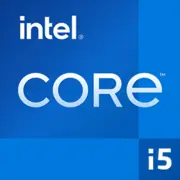Intel Core i5-13500H

Intel Core i5-13500H: パワーとモビリティのバランスを2025年に実現
現代のノートパソコンは、プロセッサに高いパフォーマンスだけでなく、エネルギー効率も求めています。Raptor Lakeアーキテクチャに基づいて発表されたIntel Core i5-13500Hは、汎用デバイス向けの最も人気のあるソリューションの一つとなりました。何が際立っていて、誰に適しているのかを見ていきましょう。
1. アーキテクチャとプロセス: ハイブリッドアプローチと新技術
Intel Core i5-13500Hプロセッサは、2種類のコアを組み合わせたハイブリッドアーキテクチャRaptor Lakeに基づいています。
- パフォーマンスコア (P-cores): 4つの高性能コアでHyper-Threadingをサポート (合計8スレッド)。ベースクロックは2.6 GHz、最大ターボクロックは4.7 GHzです。
- 効率的コア (E-cores): 8つのエネルギー効率の良いコア(8スレッド)で、ベースクロックは1.9 GHz、ターボは最大3.5 GHzです。
総コア数は12、スレッド数は16で、マルチタスクに最適なプロセッサです。
- プロセス: Intel 7(10nm Enhanced SuperFin)。Alder Lakeに比べて、エネルギー消費の最適化と負荷における周波数の安定性向上が含まれています。
- キャッシュ: 18MBのL3キャッシュは、リソース集約型アプリケーションでのデータ処理を加速します。
- 統合グラフィックス: Intel Iris Xe(80 EUで最大1450 MHz)。4Kディスプレイをサポートし、AV1デコードや軽めのゲーム(例えば、CS2を中設定でプレイすると40-50 FPS)にも対応します。
2. TDP 45W: パワーと熱のバランス
TDP(Thermal Design Power)45Wは、高性能モバイルプロセッサセグメントに属することを示しています。これにより以下のことが意味されます:
- パフォーマンスノートパソコン: このCPUを搭載したデバイスは、通常2つのファンと銅製ヒートパイプを備えた冷却システムが装備されています。
- 動作モード: エコモードではTDPが35Wまで下がり、ターボでは一時的に95Wに達します。しかし、質の高い冷却なしでは周波数がすぐに低下します。
- 実際の例: ASUS ZenBook Pro 14 (2025)のi5-13500Hでは、負荷時の温度が75℃を超えず、コンパクトなHP Pavilion 15(高性能冷却なし)では、レンダリング10分で早くもプロセッサがサーマルスロットリングを起こします。
3. パフォーマンス: オフィスからゲームまで
オフィス作業:
- Chromeで30以上のタブ、Excelシート、Zoomを同時に扱いながら、CPUの負荷は30%を超えません。
- Word、Photoshop、ストリーミング動画の起動は、16スレッドのおかげで瞬時にアプリケーション間を切り替えられます。
マルチメディア:
- Premiere Proでの10分動画のレンダリング(1080p)は約8分、一方i5-12500Hでは約12分かかります。
- LightroomでのAIフィルターを使用した写真編集では、RAWファイルを扱ってもラグがありません。
ゲーム:
- 統合グラフィックスで: GTA Vは45-50 FPS(1080p、低設定)、Fortniteは60 FPS(720p、中設定)。
- ディスクリートGPU(例えば、NVIDIA RTX 4050)と組み合わせると: Cyberpunk 2077は60 FPS(1080p、中設定、DLSS使用)。
ターボブーストモード:
- Cinebench R23ベンチマークで、シングルスレッドの結果は1800ポイント、マルチスレッドは13500ポイント。しかし、テスト後5分で性能は12-15%低下します。
4. 使用シナリオ: 誰がi5-13500Hに適しているのか?
- 学生およびオフィスワーカー: マルチタスク + 中程度の価格のノートパソコン(900ドル以上)。
- クリエイティブな専門家: ビデオ編集や3Dモデリングに適しているが、重いプロジェクトにはi7/Ryzen 7の方が良い。
- ゲーマー: ディスクリートGPUと組み合わせれば、AAAタイトルを快適にプレイ可能。
- 旅行者: このCPUを搭載したノートパソコンは1.8〜2.2kgの重さで、頻繁な移動には適しています。
5. バッテリー寿命: どれくらい持つか?
- 省エネ技術:
- Intel Dynamic Tuning 3.0: バッテリー駆動時にTDPを自動的に低下させます。
- Adaptix™ Technology: リアルタイムでコアへの負荷を最適化します。
- バッテリー寿命の例:
- 動画視聴(1080p、輝度50%)で最大8時間(70Whのバッテリー搭載のノートパソコンの場合)。
- オフィス作業 + ブラウジングで6〜7時間。
- ゲーム(ネット接続なし)で1.5時間未満。
6. 競合との比較
- AMD Ryzen 7 7735HS: 8つのZen 3+コア、TDP35W。マルチスレッドタスクにおいては優れている(Cinebench R23では14500ポイント)が、シングルスレッドでは劣る(1700ポイント)。ノートパソコンの価格は似ています。
- Apple M3: よりエネルギー効率が良く(MacBook Proで18時間のバッテリー寿命)、しかしWindowsプログラムとの互換性が限られています。
- Intel Core i7-13700H: マルチスレッドテストで15〜20%パワフルですが、価格は高め(1300ドル以上対900~1100ドルのi5)。
7. メリットとデメリット
メリット:
- 汎用タスクに最適です。
- DDR5-5600およびPCIe 5.0(高速SSDおよび外部GPU)のサポート。
- 優れた統合グラフィックス。
デメリット:
- 薄型ノートパソコンでは熱が問題になる可能性がある。
- 積極的に使用すると平均的なバッテリー寿命。
8. ノートパソコン選びの推奨
- ウルトラブック(例:Dell XPS 13): 軽量(1.3kg未満)ですが、TDPは35Wまで制限される場合があります。
- ゲーミングモデル(MSI Katana 15): 強力な冷却、ディスクリートグラフィックスを搭載しますが、重さは2.5kgから。
- ワークステーション(Lenovo ThinkPad P16s): 高い信頼性、ECCメモリをサポート。
注意点:
- 冷却システム: 少なくとも2つのファンがあります。
- RAM: 16GB以上のDDR5。
- ディスプレイ: 創造的なタスクには100% sRGB、ゲームには144Hzが必要です。
9. 最終的な結論
Intel Core i5-13500Hは、パフォーマンス、価格、モビリティのバランスを求める人にとって理想的な選択です。
- 「あらゆる用途に適した」ノートパソコンを必要とするユーザー。
- 重量とパワーの妥協を受け入れられるゲーマー。
- 外出先でグラフィックスとビデオを扱う専門家。
主要な利点:
- ほとんどのタスクに対応できる十分なパワーを持ちながら、ハイエンドモデルに過大な支払いをする必要なし。
- 最新技術(PCIe 5.0、Thunderbolt 4)。
- 手頃な価格: i5-13500Hを搭載したノートパソコンは900ドルから。
フラグシップのi7にお金を払う準備がないが、1年後に古くならないデバイスを望んでいるなら、i5-13500Hは2025年の市場でのベストな選択肢の一つです。
基本
CPUの仕様
メモリ仕様
GPUの仕様
その他
ベンチマーク
他のCPUとの比較
ソーシャルメディアで共有する
または当サイトへのリンクを追加
<a href="https://cputronic.com/ja/cpu/intel-core-i5-13500h" target="_blank">Intel Core i5-13500H</a>

